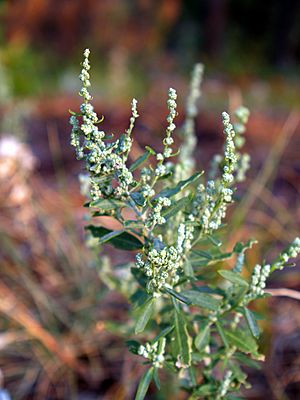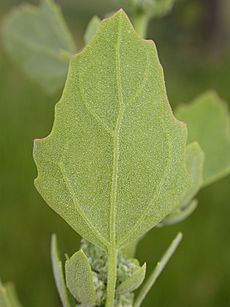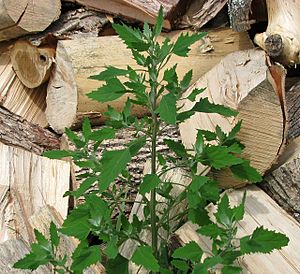Pitseed goosefoot facts for kids
Quick facts for kids Pitseed goosefoot |
|
|---|---|
 |
|
| Scientific classification | |
| Genus: |
Chenopodium
|
| Species: |
berlandieri
|
Chenopodium berlandieri is a type of plant that grows every year. It's known by many names like pitseed goosefoot, huauzontle, and lamb's quarters. This plant belongs to the Amaranthaceae family.
You can find Chenopodium berlandieri all over North America, from Canada down to Michoacán, Mexico. It grows in almost every U.S. state! This plant grows very fast and can get taller than 3 meters (about 10 feet). You can tell it apart from other similar plants by its unique seeds, which look like tiny honeycombs. Its lower leaves also have jagged edges.
Even though many people think of it as a weed, this plant was once very important. Native Americans grew it long ago as part of their farming system called the Eastern Agricultural Complex. C. berlandieri was a domesticated crop, much like its relative, quinoa. Today, it's still grown in Mexico. People use its seeds like a grain, its leaves as a vegetable, and its flower shoots, which look a bit like broccoli.
Contents
What Does Chenopodium berlandieri Look Like?
This plant has special features that help us identify it.
Its Seeds
The seeds of Chenopodium plants can be round and flat (like a lentil) or more cylinder-shaped. Wild plants usually have the round, flat seeds. However, the types of Chenopodium that people grow often have the cylinder-shaped seeds.
Inside the seed, there's a part called the perisperm which stores food. A tiny plant-to-be, called the embryo, wraps around this food storage. The part of the embryo that will become the root, called the radicle, sticks out a little, making a small bump on the seed.
The seed has several layers protecting it. There's an inner and an outer layer, which together make up the seed coat. In plants that have been grown by people for a long time, this seed coat can be very thin or even missing. If a group of seeds all have very thin coats (less than 20 micrometers thick), it usually means they came from domesticated plants. Wild plants tend to have thicker seed coats.
Different Types of Chenopodium berlandieri
This plant has two main groups, called subspecies:
- C. b. ssp. berlandieri (the wild type)
- C. b. ssp. nuttalliae
The second type, C. b. ssp. nuttalliae, is a domesticated plant grown in Mexico. It's also known as huauzontle or Nuttall's goosefoot.
There are also several different kinds (called varieties) of the wild C. b. ssp. berlandieri:
- C. b. subsp. berlandieri var. berlandieri
- C. b. subsp. berlandieri var. boscianum
- C. b. subsp. berlandieri var. bushianum (Bush's goosefoot)
- C. b. subsp. berlandieri var. macrocalycium
- C. b. subsp. berlandieri var. sinuatum
- C. b. subsp. berlandieri var. zschackii (Zschack's goosefoot)
Long ago, there was also an extinct variety called C. b. subsp. jonesianum.
The domesticated C. b. nuttalliae subspecies has special types called cultivars, which are grown for different uses:
- Huauzontle: This type is grown for its broccoli-like flower shoots. Its seed coat is very thin, only 2-7 micrometers thick. (To compare, a human hair is about 100 micrometers wide!)
- Chia: This type is grown for its seeds, like a grain. It's not as common now and is mostly grown locally. Its seed coat is also thin, about 10-20 micrometers.
- Quelite: This type is grown for its leaves, which are eaten like spinach.
C. berlandieri can also mix with a similar plant from Europe called Chenopodium album. When they mix, they create a hybrid plant called C. × variabile.
How Chenopodium berlandieri Was Domesticated
C. berlandieri is the original plant from which all other domesticated Chenopodium plants in North and South America came. In ancient times, in eastern North America, it was a key part of the Eastern Agricultural Complex. This was a group of plants that helped feed people who lived in one place or moved around.
Scientists have found proof that people started gathering wild C. berlandieri as early as 6,500 BC. By 1700 BC, people had clearly started growing it as a crop for its grain-like seeds. The domesticated type was named C. b. ssp. jonesianum. The oldest signs of this domestication come from hidden stashes of thin-coated seeds found in rock shelters in the Ozark Plateaus and Ohio River basin.
However, when Europeans came to America, people in eastern North America stopped growing this plant. One old record from around 1720 by Antoine-Simon Le Page du Pratz might be about C. b. ssp. jonesianum. He wrote about a grain-like crop called Choupichoul that the Natchez people grew. It was tasty, healthy, grew a lot, and didn't need much work. Many clues suggest this crop was a domesticated C. berlandieri.
Even though it's not grown much in eastern North America anymore, C. b. subsp. nuttalliae is still an important crop in Mexico. As mentioned, three types of this subspecies are grown for their grain-like seeds, leaves, and broccoli-like flower shoots.
The biggest difference between wild and domesticated Chenopodium plants is how thick their seed coats are. In domesticated plants, the seed coats are less than 20 microns thick. This is because people chose to grow plants with thinner seed coats over many generations. Wild plants, however, have much thicker seed coats, usually 40 to 60 microns thick. Both the modern Mexican C. b. subsp. nuttalliae and the ancient C. b. ssp. jonesianum share this thin seed coat feature.
Genetic studies show that the cultivated plants from eastern North America and Mexico are quite different from each other. This means that C. berlandieri was likely domesticated at least two separate times in North America. Similarly, the South American types, which are now called C. quinoa (quinoa), also likely had at least two separate domestication events.
Is Chenopodium berlandieri a Weed?
Chenopodium plants are known to be big weed problems for farms in North America and around the world. Most research talks about the European species C. album as a weed that can resist herbicides (weed killers). It's sometimes hard to tell if C. berlandieri is also a weed problem because it looks so similar to C. album.
As quinoa farming has spread globally, it now grows in areas where its wild relatives, like C. berlandieri in North America, also grow. When these plants grow close together, they can cross-pollinate and create a mix of crop and weed plants. This mixing can sometimes be bad for both the crops and the wild plants. However, it can also create new types of crops! Interestingly, this mixing of quinoa and C. berlandieri today is similar to how domesticated and wild Chenopodium plants interacted long ago in eastern North America.
See also
 In Spanish: Huazontle para niños
In Spanish: Huazontle para niños



